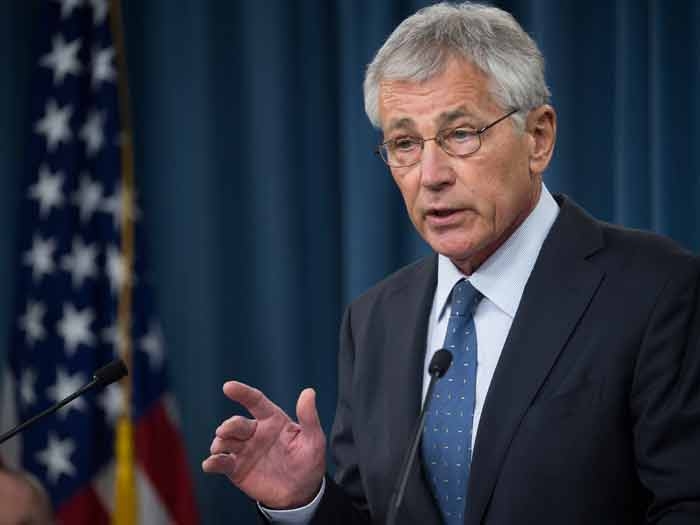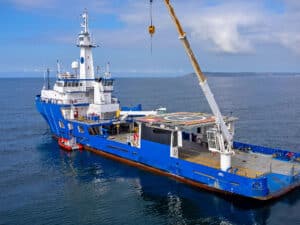
Navy budget stresses new ships, but LCS numbers in doubt
Written by Nick Blenkey
FEBRUARY 25, 2014 — “Under the President’s budget plan, the Navy will launch an aggressive and ambitious effort to reduce acquisitions costs and maximize resources available to buy and build new ships,” Secretary of Defense Chuck Hagel said at a Pentagon press briefing yesterday in which he presented highlights of the defense budget for 2015 that the Obama Administration will present to Congress next week.
He also expressed concerns about the LCS program, including whether it has the independent protection and firepower to operate and survive against a more advanced military adversary and emerging new technologies and said no new LCS contract negotiations beyond 32 ships will go forward. Secretary Hagel says he has directed the Navy to submit alternative proposals to procure a “small surface combatant, generally consistent with the capabilities of a frigate.”
Secretary Hagel spelled out the fact the budget recommendations are being made in the context of severe spending restraints. He noted that, although this year’s Bipartisan Budget Act,gives DoD much-needed budget certainty for the next fiscal year, defense spending remains significantly below what the President requested in his FY 2014 budget request and five year budget plan.
He said that the spending levels proposed under the President’s budget plan would also enable the Navy to maintain 11 carrier strike groups.
“However,” he said, “we will have to make a final decision on the future of the George Washington aircraft carrier in the 2016 budget submission. If sequestration spending levels remain in place in Fiscal Year 2016, she would need to be retired before her scheduled nuclear refueling and overhaul. That would leave the Navy with 10 carrier strike groups. But keeping the George Washington in the fleet would cost $6 billion – so we would have no other choice than to retire her should sequestration-level cuts be re-imposed. At the President’s budget level, we would pay for the overhaul and maintain 11 carriers.
“In order to help keep its ship inventory ready and modern under the President’s plan, half of the Navy’s cruiser fleet – or eleven ships – will be ‘laid up’ and placed in reduced operating status while they are modernized, and eventually returned to service with greater capability and a longer lifespan. This approach enables us over the long-term to sustain and modernize our fleet of cruisers, which are the most capable ships for controlling the air defense of a carrier strike group.
“Overall, the Navy’s fleet will be significantly modernized under our plan, which continues buying two destroyers and two attack submarines per year, as well as one additional Afloat Staging Base. We have preserved the fleet’s modernization programs and provided for increases in ship inventory over the next five years.
“Regarding the Navy’s Littoral Combat Ship, I am concerned that the Navy is relying too heavily on the LCS to achieve its long-term goals for ship numbers. Therefore, no new contract negotiations beyond 32 ships will go forward. With this decision, the LCS line will continue beyond our five-year budget plan with no interruptions.
“The LCS was designed to perform certain missions – such as mine sweeping and anti-submarine warfare – in a relatively permissive environment. But we need to closely examine whether the LCS has the independent protection and firepower to operate and survive against a more advanced military adversary and emerging new technologies, especially in the Asia Pacific. If we were to build out the LCS program to 52 ships, as previously planned, it would represent one-sixth of our future 300-ship Navy. Given continued fiscal restraints, we must direct future shipbuilding resources toward platforms that can operate in every region and along the full spectrum of conflict.
“Additionally, at my direction, the Navy will submit alternative proposals to procure a capable and lethal small surface combatant, generally consistent with the capabilities of a frigate. I’ve directed the Navy to consider a completely new design, existing ship designs, and a modified LCS. These proposals are due to me later this year in time to inform next year’s budget submission.
“If sequestration spending levels return in 2016 and beyond, we will be forced into much tougher decisions on the Navy surface fleet. Six additional ships would have to be laid up, and we would have to slow the rate at which we buy destroyers. The net result of sequestration-level cuts would be ten fewer large surface combatant ships in the Navy’s operational inventory by 2023. Under sequestration spending levels, the Navy would also halt procurement of the carrier variant of the Joint Strike Fighter for two years.”
“





Leave a Reply
You must be logged in to post a comment.